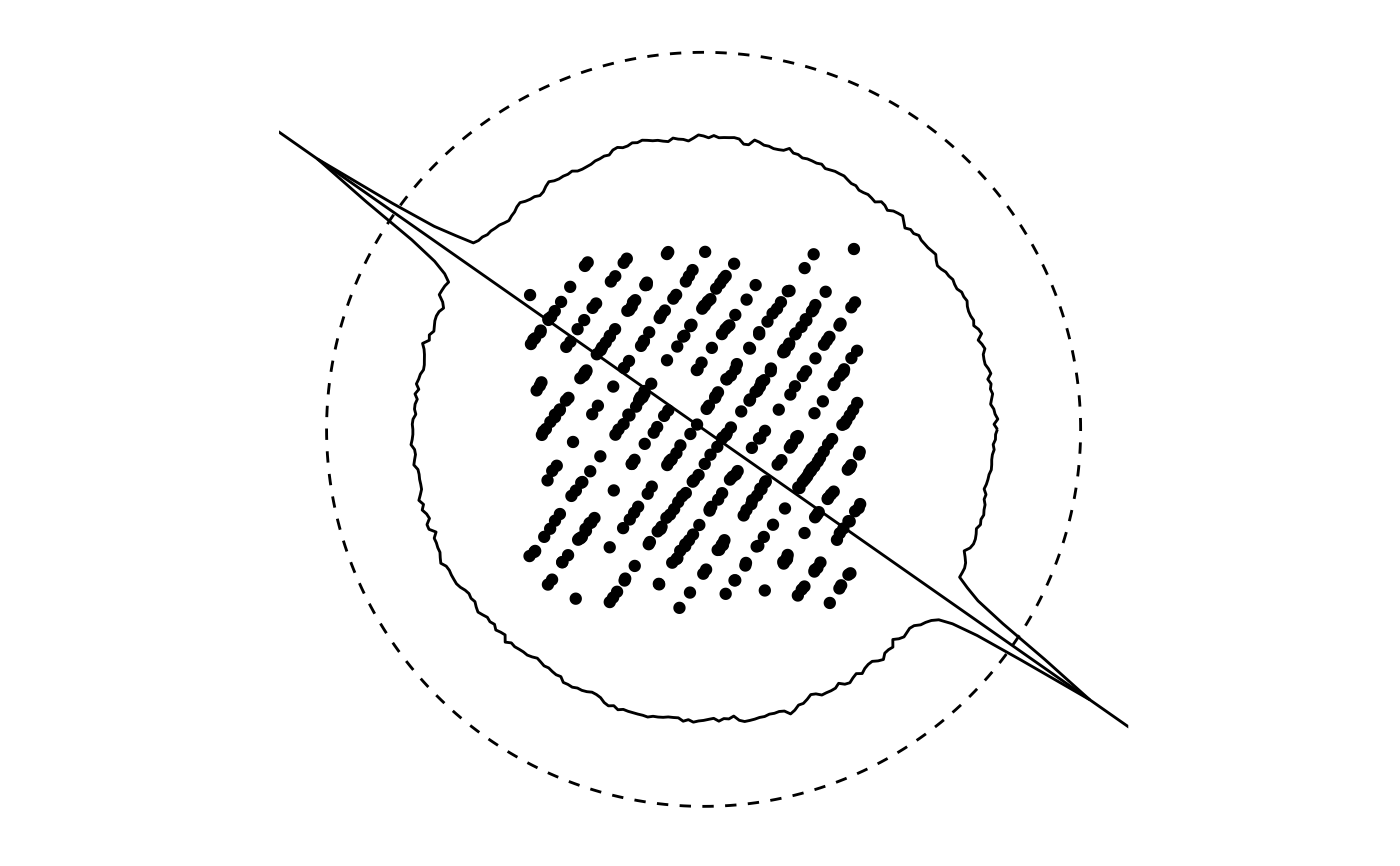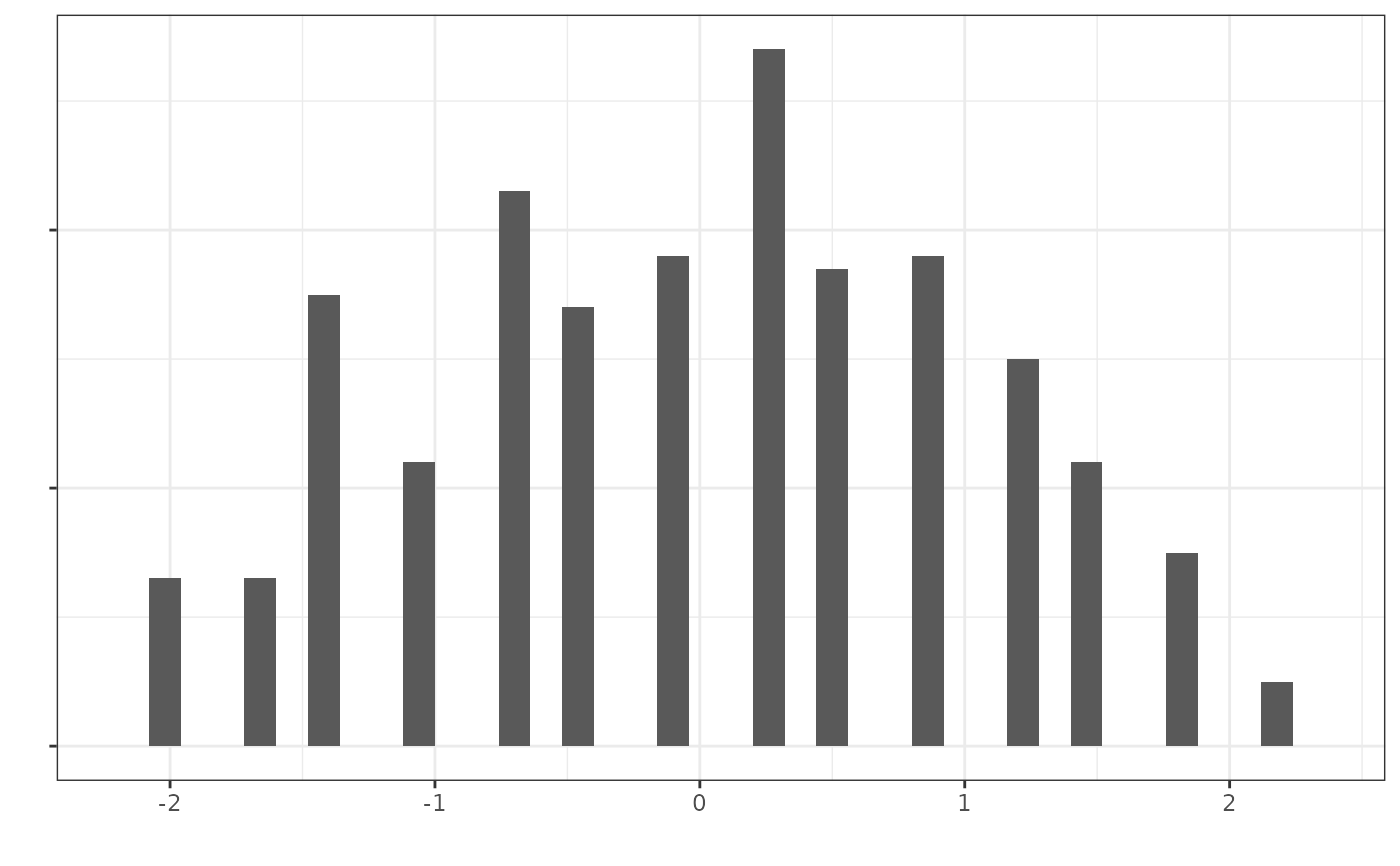The Huber plot presents the projection pursuit index values of 2D data in each 1D
projection in polar coordinates, corresponding to each projection direction.
It offers a simpler illustration of more complex projection from
high-dimensional data to lower dimensions in projection pursuit. The
function prep_huber() calculates each component required for the Huber plot
(see details), which can then be supplied to various geom layers in ggplot2.
Usage
StatHuber
stat_huber(
mapping = NULL,
data = NULL,
geom = "path",
position = "identity",
...,
index.fun,
na.rm = FALSE,
show.legend = NA,
inherit.aes = TRUE
)
geom_huber(
mapping = NULL,
data = NULL,
stat = "identity",
position = "identity",
index.fun,
ref.circle.color = NULL,
ref.circle.colour = NULL,
ref.circle.linetype = "dashed",
ref.circle.linewidth = NULL,
idx.max.color = NULL,
idx.max.colour = NULL,
idx.max.linetype = "dashed",
idx.max.linewidth = NULL,
idx.profile.color = NULL,
idx.profile.colour = NULL,
idx.profile.linetype = "solid",
idx.profile.linewidth = NULL,
proj.points.color = NULL,
proj.points.colour = NULL,
proj.points.stroke = NULL,
proj.points.alpha = NULL,
proj.points.size = NULL,
proj.points.shape = NULL,
na.rm = FALSE,
show.legend = NA,
inherit.aes = TRUE,
...
)
GeomHuber
prep_huber_best_proj(data, index_fun)
theme_huber(...)Format
An object of class StatHuber (inherits from Stat, ggproto, gg) of length 3.
An object of class GeomHuber (inherits from Geom, ggproto, gg) of length 4.
Arguments
- mapping
Set of aesthetic mappings created by
aes(). If specified andinherit.aes = TRUE(the default), it is combined with the default mapping at the top level of the plot. You must supplymappingif there is no plot mapping.- data
The data to be displayed in this layer. There are three options:
If
NULL, the default, the data is inherited from the plot data as specified in the call toggplot().A
data.frame, or other object, will override the plot data. All objects will be fortified to produce a data frame. Seefortify()for which variables will be created.A
functionwill be called with a single argument, the plot data. The return value must be adata.frame, and will be used as the layer data. Afunctioncan be created from aformula(e.g.~ head(.x, 10)).- geom
The geometric object to use to display the data for this layer. When using a
stat_*()function to construct a layer, thegeomargument can be used to override the default coupling between stats and geoms. Thegeomargument accepts the following:A
Geomggproto subclass, for exampleGeomPoint.A string naming the geom. To give the geom as a string, strip the function name of the
geom_prefix. For example, to usegeom_point(), give the geom as"point".For more information and other ways to specify the geom, see the layer geom documentation.
- position
A position adjustment to use on the data for this layer. This can be used in various ways, including to prevent overplotting and improving the display. The
positionargument accepts the following:The result of calling a position function, such as
position_jitter(). This method allows for passing extra arguments to the position.A string naming the position adjustment. To give the position as a string, strip the function name of the
position_prefix. For example, to useposition_jitter(), give the position as"jitter".For more information and other ways to specify the position, see the layer position documentation.
- ...
Other arguments passed on to
layer()'sparamsargument. These arguments broadly fall into one of 4 categories below. Notably, further arguments to thepositionargument, or aesthetics that are required can not be passed through.... Unknown arguments that are not part of the 4 categories below are ignored.Static aesthetics that are not mapped to a scale, but are at a fixed value and apply to the layer as a whole. For example,
colour = "red"orlinewidth = 3. The geom's documentation has an Aesthetics section that lists the available options. The 'required' aesthetics cannot be passed on to theparams. Please note that while passing unmapped aesthetics as vectors is technically possible, the order and required length is not guaranteed to be parallel to the input data.When constructing a layer using a
stat_*()function, the...argument can be used to pass on parameters to thegeompart of the layer. An example of this isstat_density(geom = "area", outline.type = "both"). The geom's documentation lists which parameters it can accept.Inversely, when constructing a layer using a
geom_*()function, the...argument can be used to pass on parameters to thestatpart of the layer. An example of this isgeom_area(stat = "density", adjust = 0.5). The stat's documentation lists which parameters it can accept.The
key_glyphargument oflayer()may also be passed on through.... This can be one of the functions described as key glyphs, to change the display of the layer in the legend.
- index.fun, index_fun
the projection pursuit index function, see examples
- na.rm
If
FALSE, the default, missing values are removed with a warning. IfTRUE, missing values are silently removed.- show.legend
logical. Should this layer be included in the legends?
NA, the default, includes if any aesthetics are mapped.FALSEnever includes, andTRUEalways includes. It can also be a named logical vector to finely select the aesthetics to display. To include legend keys for all levels, even when no data exists, useTRUE. IfNA, all levels are shown in legend, but unobserved levels are omitted.- inherit.aes
If
FALSE, overrides the default aesthetics, rather than combining with them. This is most useful for helper functions that define both data and aesthetics and shouldn't inherit behaviour from the default plot specification, e.g.annotation_borders().- stat
The statistical transformation to use on the data for this layer. When using a
geom_*()function to construct a layer, thestatargument can be used to override the default coupling between geoms and stats. Thestatargument accepts the following:A
Statggproto subclass, for exampleStatCount.A string naming the stat. To give the stat as a string, strip the function name of the
stat_prefix. For example, to usestat_count(), give the stat as"count".For more information and other ways to specify the stat, see the layer stat documentation.
- ref.circle.color, ref.circle.colour, ref.circle.linetype, ref.circle.linewidth
Default aesthetics for the reference circle
- idx.max.color, idx.max.colour, idx.max.linetype, idx.max.linewidth
Default aesthetics for the line indicating the best projection direction
- idx.profile.color, idx.profile.colour, idx.profile.linetype, idx.profile.linewidth
Default aesthetics for the index profile line
- proj.points.color, proj.points.colour, proj.points.stroke, proj.points.alpha, proj.points.size, proj.points.shape
Default aesthetics for the projected data points
Details
the prep_huber() function calculates components required for
making the Huber plots. It returns a list including three elements:
- the
idx_dfdata frame: the x/y coordinates of the index value, in polar coordinates. Used for plotting the index value at each projection direction, with the reference circle.
- the
proj_dfdata frame: the best 1D projection. Used for plotting the 1D projection in histogram.
- the
slopevalue: the slope to plot in the Huber plot to indicate the direction of the best 1D projection.
Examples
library(ggplot2)
library(tourr)
library(ash)
data(randu)
# simplify the randu data into 2D for illustration
randu_std <- as.data.frame(apply(randu, 2, function(x) (x-mean(x))/sd(x)))
randu_std$yz <- sqrt(35)/6*randu_std$y-randu_std$z/6
randu_df <- randu_std[c(1,4)]
# main example: Huber plot with geom_huber()
randu_df |>
ggplot() +
geom_huber(aes(x = x, y = yz), index.fun = norm_bin(nr = nrow(randu_df))) +
coord_fixed() +
theme_huber()
 # compute the best projection data for histogram
randu_huber_best <- prep_huber_best_proj(
randu_df, index_fun = norm_bin(nr = nrow(randu_df))
)
randu_huber_best |>
ggplot() +
geom_histogram(aes(x = x), breaks = seq(-2.2, 2.4, 0.12)) +
xlab("") + ylab("") +
theme_bw() +
theme(axis.text.y = element_blank())
# compute the best projection data for histogram
randu_huber_best <- prep_huber_best_proj(
randu_df, index_fun = norm_bin(nr = nrow(randu_df))
)
randu_huber_best |>
ggplot() +
geom_histogram(aes(x = x), breaks = seq(-2.2, 2.4, 0.12)) +
xlab("") + ylab("") +
theme_bw() +
theme(axis.text.y = element_blank())

